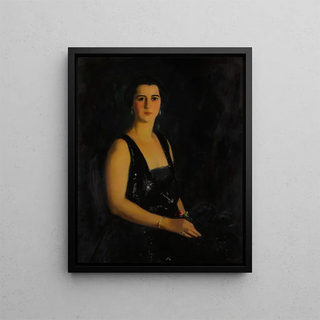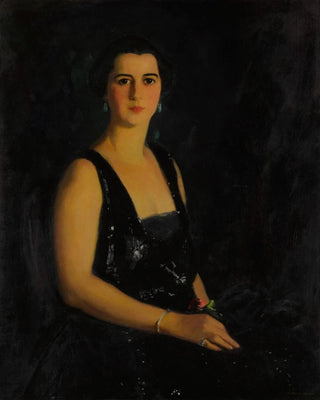Art print | Portrait of Mrs. Arthur Bond Cecil - Robert Henri


View from behind

Frame (optional)
In the fascinating universe of art, some works transcend their era to capture the very essence of humanity. The "Art print of Mrs. Arthur Bond Cecil" by Robert Henri is one of those creations that, through its emotional depth and stylistic boldness, invites the viewer to an intimate exploration of the human psyche. This piece, created in the early 20th century, bears witness to a time when art was freeing itself from academic constraints to embrace a more personal and expressive vision. Henri, a prominent figure of the American movement known as the Ashcan School, manages to capture not only the external appearance of his model but also her inner essence, rendering this portrait with rare intensity.
Style and uniqueness of the work
Robert Henri's style in this piece is characterized by a bold approach and a vibrant color palette that capture light and emotion. The portrait exudes an atmosphere of closeness and intimacy, as if the artist had succeeded in establishing a silent dialogue between himself and his model. The brushstrokes, both energetic and delicate, reveal technical mastery that allows textures of skin and clothing to be rendered with striking precision. The composition, far from being static, suggests subtle movement, a breath, that brings the depicted figure to life. This portrait does not merely depict a woman; it tells a story, that of a time, a personality, and an artistic vision that refuses to conform to established norms.
The artist and his influence
Robert Henri, born in 1865, was an American painter who played a crucial role in the development of modern art in the United States. As a leader of the Ashcan movement, he sought to depict the daily life of ordinary people with unprecedented sincerity and humanity. Henri was influenced by European artists such as Édouard Manet and Vincent van Gogh, but he developed a style that is uniquely his own, characterized by a direct approach and sensitivity to nuances of light and shadow. His work paved the way for many American artists, encouraging a deeper exploration of urban life and human emotions. The "Art print of Mrs.

Matte finish

View from behind

Frame (optional)
In the fascinating universe of art, some works transcend their era to capture the very essence of humanity. The "Art print of Mrs. Arthur Bond Cecil" by Robert Henri is one of those creations that, through its emotional depth and stylistic boldness, invites the viewer to an intimate exploration of the human psyche. This piece, created in the early 20th century, bears witness to a time when art was freeing itself from academic constraints to embrace a more personal and expressive vision. Henri, a prominent figure of the American movement known as the Ashcan School, manages to capture not only the external appearance of his model but also her inner essence, rendering this portrait with rare intensity.
Style and uniqueness of the work
Robert Henri's style in this piece is characterized by a bold approach and a vibrant color palette that capture light and emotion. The portrait exudes an atmosphere of closeness and intimacy, as if the artist had succeeded in establishing a silent dialogue between himself and his model. The brushstrokes, both energetic and delicate, reveal technical mastery that allows textures of skin and clothing to be rendered with striking precision. The composition, far from being static, suggests subtle movement, a breath, that brings the depicted figure to life. This portrait does not merely depict a woman; it tells a story, that of a time, a personality, and an artistic vision that refuses to conform to established norms.
The artist and his influence
Robert Henri, born in 1865, was an American painter who played a crucial role in the development of modern art in the United States. As a leader of the Ashcan movement, he sought to depict the daily life of ordinary people with unprecedented sincerity and humanity. Henri was influenced by European artists such as Édouard Manet and Vincent van Gogh, but he developed a style that is uniquely his own, characterized by a direct approach and sensitivity to nuances of light and shadow. His work paved the way for many American artists, encouraging a deeper exploration of urban life and human emotions. The "Art print of Mrs.






